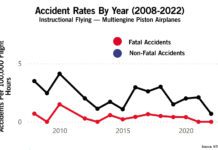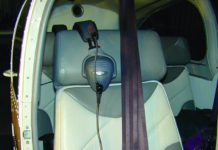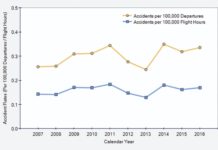The following briefs were selected from the 224 preliminary reports filed with the NTSB in July 2002. Statements in quotes were taken directly from the NTSB documents. The information is subject to change as the investigations are completed. Click here to view “Accident Totals, July.”
———-
July 02, Houston, Texas
McDonnell Douglas MD-88
At 0922 central time, a McDonnell Douglas MD-88 operated by Delta Air Lines collided with parked construction trucks at Houston Hobby Airport. There were no injuries. The flight had been cleared to cross runway 22 and taxi to the gate. The pilot taxied on taxiway Zulu, which is parallel to taxiway Yankee, which was open. Taxiway Zulu was closed due to construction; however, the construction was not posted on the ATIS, NOTAM, or dispatchers release from the company. Ground control did not mention that taxiway Zulu was closed.
July 02, Lebanon, Tenn.
Piper Arrow
At 1500 central time, a Piper PA-28RT-201 struck power lines after takeoff from Lebanon Municipal Airport. The flight instructor and pilot-rated student were killed and a pilot-rated passenger suffered minor injuries. The passenger said he heard the instructor telling the student to keep the airspeed up, then the instructor turned to avoid trees and hit the power lines. Witnesses said the airplane took off extremely nose-high and never climbed much.
July 02, Mt. Pleasant, S.C.
Mooney Ovation
At about 1430 eastern time, a Mooney M20R crashed during an attempted go-around at East Cooper Airport. The pilot was not injured. The pilot said he approached slightly fast, touched down a third of the way down the runway, and bounced. He added power and raised the flaps and the airplane yawed left and hit the ground. A witness said the airplane initially struck nosewheel first and porpoised three or four times before the pilot attempted the go-around.
July 03, Atlantic Ocean
Rockwell Commander 112TC
At about 1450 eastern time, a Rockwell Commander 112TC ditched into the Atlantic Ocean about 10 to 12 miles east of Stuart, Fla., apparently after running out of fuel. The two occupants were not injured. The pilot departed Daytona Beach for Marsh Harbour, Bahamas, where he added 10 gallons of fuel to get him back to Fort Pierce, Fla. He declared a fuel problem at 1446 and ditched the airplane four minutes later. The pilot said he did not measure the fuel aboard at any time, but had estimated it based on a visual inspection of the fuel level relative to the metal tabs. The owner of the airplane indicated the accident pilot had not properly calculated fuel consumption at the power and mixture settings he used.
July 03, Shelley, Idaho
Grumman-Schweizer Agcat
At approximately 2030 mountain time, a Grumman G-164B lost engine power and crashed after a spray run near Shelley. The pilot suffered minor injuries. Post-crash examination revealed the top of the No. 5 cylinder had separated. The pilot said the Pratt & Whitney R-985 engine had been overhauled within the previous 100 hours.
July 03, Sprakers, N.Y.
KitFox
At about 1830 eastern time, an unregistered KitFox airplane crashed in the traffic pattern at a private airstrip near Sprakers. The unlicensed pilot, who was killed, had just completed construction of the aircraft. A witness said they were performing taxi tests and fixed a minor squawk, after which the pilot said he was going to go for it. The airplane did four right traffic patterns, with rough engine sounds and severe pitch oscillations evident throughout. The first pattern was a low pass. The next two involved go-arounds after bounced landings. On the fourth the left wing hit the ground and the airplane stopped. They determined the wing was not damaged and adjusted the carburetor. The pilot then restarted the engine and took off again. He made five right traffic patterns, with the bank and pitch oscillations under better control and the engine running smoothly. The first pattern was a low pass. The next four were go-arounds after bounced landings. After the fourth, the airplane entered a steep climb, banked left 60 degrees and spun to the ground.
July 05, Pahrump, Nev.
Mustang M-11
At about 1200 Pacific time, an amateur-built Mustang M-11 suffered a propeller blade failure during cruise and made a forced landing on a dry lake bed near Pahrump. The pilot and passenger were not injured. The pilot said he experienced a propeller blade failure, with about 21 inches of the aluminum two-bladed McCauley fixed pitch prop separated. The resultant imbalance left the engine hanging by one 3/8-inch bolt.
July 06, Otis, Ore.
Cessna 172
At approximately 0930 Pacific time, a Cessna 172N struck power lines and crashed near Otis, killing the pilot and passenger. Witnesses said the airplane was cruising low over the Salmon Creek inlet when it executed an abrupt climbing left turn as it approached power lines spanning the creek. The power lines were suspended about 60 feet high. The airplane then crashed on a sandbar exposed by low tide.
July 07, Andover, N.J.
Piper Cub
At about 1100 eastern time, a Piper J3-C65 crashed during a training exercise near Trinca Airport. The flight instructor was seriously injured and the pilot-rated student suffered minor injuries. The pilot was undergoing tailwheel training and was on initial climb after a touch-and-go when the instructor pulled power to simulate an engine failure. The instructor urged the pilot to lower the nose, but the pilot continued to slow the airplane until it stalled and spun into a cornfield.
July 08, Denton, Texas
Cessna 172
At 1202 central time, a Cessna 172 overran the runway at Denton Municipal Airport and struck localizer antennae. The pilot suffered minor injuries and the passenger was killed. The 2,000-hour pilot said he was distracted by an airplane taking off, bounced twice and didnt touch down until only about 270 feet remained on the 6,000-foot runway. The airplane struck several antennae and stopped 412 feet past the end of the runway.
July 09, Mesa, Ariz.
Beech Baron
At 1914 mountain time, a Beech 95-B55 landed hard on runway 22L at Falcon Field Airport, collapsing the right main landing gear. The pilot was not injured. A special weather report was issued four minutes earlier, showing the winds at 150-degrees at 18 knots, gusting to 28; with blowing dust. Controllers advised the pilot of the winds four times during the approach. The pilot said he touched down and the airplane was caught by a gust of wind. He added power to go around and was slammed back down on the runway.
July 10, Pickens, S.C.
Cessna 172
At about 2233 eastern time, a Cessna 172N crashed while attempting to take off from Pickens County Airport. The pilot was not injured. The pilot said he rented the accident airplane because his airplane was inoperable. He said he did not see the gust lock installed in the airplane because it was dark. During the takeoff roll, he attempted to rotate and then discovered the gust lock. He attempted to abort the takeoff but the airplane ran past the end of the runway.
July 12, Boca Raton, Fla.
American General Traveler
At about 1332 eastern time, an American General AA-5 crashed during an emergency descent near Boca Raton, killing the pilot and a pilot-rated passenger. The pilot declared an emergency on the Tower frequency for Fort Lauderdale Executive Airport, saying the flight was at 400 feet, descending at 400 feet per minute at 80 miles per hour. He did not give the nature of the emergency. The wreckage was found inverted in a marshy area.
July 13, Purcell, Okla.
Piper Warrior
At 2155 central time, a Piper PA-28-161 suffered an inflight fire during a night cross-country flight. The pilot landed the airplane on Interstate 35 near Purcell without hitting anything, but all four occupants suffered minor injuries during the accident. The fire apparently started under and behind one of the passenger seats. The fire consumed the fuselage and cabin.
July 13, Spicewood, Texas
Grumman Tiger
At 1130 central time, a Grumman American AA-5B struck fence posts while attempting to land on a road near Spicewood. The pilot was not injured. The pilot said he had never been to Spicewood and was being vectored to the airport by ATC when he mistook a road for the runway and landed the airplane. During the landing roll, the airplane veered left and struck 12 fence posts.
July 16, Grass Valley, Calif.
Cessna 210
At about 1115 Pacific time, a Cessna T210M suffered a landing gear failure and departed the runway at Nevada County Air Park. The pilot and two passengers were not injured; a third passenger suffered minor injuries. The pilot reported touching down normally and hearing a metallic clank when the right main gear touched down. He immediately pulled back on the yoke and the airplane briefly became airborne again, then he let the airplane settle back to the runway. At that point, the airplane departed the runway to the right. Broken wheel components were found on the runway.
July 17, Bardstown, KY
Boeing Stearman
At about 0940 eastern time, a Boeing A75N1 lost engine power and was damaged during the ensuing forced landing near Samuels Field Airport. The pilot and passenger sustained minor injuries. The pilot said the airplane lost power about 400 feet agl shortly after takeoff. The pilot had recently purchased the airplane at an estate sale and it had been in storage for about 12 years. A mechanic had installed a new carburetor and two new magnetos. Post-crash inspection showed large amounts of water in the wing tanks, milky white fuel, debris-clogged spark plug gaps, and carbon and rust deposits in the oil screen.
July 17, Dayton, Ohio
Waco UPF-7 and Kitfox
At about 1525 eastern time, a landing Waco UPF-7 collided with a Kitfox that was backtaxiing on the runway at Moraine Airpark. The pilot and two passengers in the Waco received minor injuries, while the pilot in the Kitfox was not injured. The Kitfox pilot said he landed in the grass next to runway 26. He then taxied east in the grass and looked down the runway and saw no traffic. He then announced on the CTAF that he was backtaxiing on runway 26, but when he entered the runway he was struck by the Waco, which was on its landing roll. The Waco was not equipped with a radio.
July 18, Lees Summit, Mo.
Piper Cherokee 180
At 0740 central time, a Piper PA-28-180 crashed shortly after takeoff from runway 18 at Lees Summit Municipal Airport. The pilot and passenger were killed. Weather at the time was reported as visibility 1 miles in mist and an overcast at 100-600 feet agl, averaging 300 feet. The 228-hour pilot was not instrument-rated.
July 19, El Dorado Springs, M.
Piper Cherokee 140
At 1445 central time, a Piper Cherokee 140 struck a line of trees 400 feet from the departure end of runway 18 at El Dorado Springs Memorial Airport. The airplane landed on runway 18 and backtaxied to the intersection of runway 4-22 before initiating the takeoff run. Approximately 1,830 feet was available from the intersection. The pilot suffered minor injuries and the passenger sustained serious injuries.
July 20, Atlantic Ocean
Piper Lance
At 0600 eastern time a Piper PA-32RT-300 ditched in the Atlantic Ocean, killing all five aboard. The aircraft was flying from Freeport, Bahamas, to West Palm Beach, Fla., when it disappeared from radio and radar contact. The Coast Guard recovered three victims and about 300 pounds of aircraft debris. The other two victims are presumed dead. The depth of the water in the search area was about 2100 feet.
July 21, Oshkosh, Wisc.
Piper Pacer
At 1520 central time, a Piper PA-20 collided with the runway following an abrupt maneuver while landing on runway 27 at Wittman Regional Airport. The pilot suffered a minor injury and the passenger was not injured. The accident occurred during the EAA AirVenture 2002 convention. The airplane was cleared to land on runway 27 and the passenger yelled that there was another airplane in their flight path. The pilot pulled back on the control yoke in order to avoid the other airplane. The airplane stalled and struck the runway. The other airplane had been cleared to land runway 18. Air Traffic Control was operating under the VFR Arrival Yellow Flow procedures as outlined in the AirVenture Notam.
July 26, Clear Spring, Md.
Beech Bonanza
At 1132 eastern time, a Beech S-35 struck terrain in cruise flight near Clear Spring, killing the pilot. Instrument meteorological conditions prevailed and a VFR flight plan was filed. The pilot departed about 1000 and then returned because he could not maintain VFR. At 1121 he departed a second time. At 1126 he requested flight following from Washington Center and said he could not maintain VFR. The Center controller suggested he return to his origination point of Hagerstown Airport and file IFR. A tower controller at Hagerstown briefly saw the airplane cruising at 1000 feet msl in an area where terrain was about 700 feet msl. Witnesses near the crash site reported rain and dense fog. The pilot, who reported more than 11,500 hours of flight time, had told the airplanes owner he would no longer fly at night or IFR.
July 26, Georgetown, Colo.
Cessna 172
At approximately 1205 mountain time, a Cessna 172S was damaged making a forced landing in a box canyon near Georgetown. The pilot and his passenger were not injured. The pilot said he performed a forced landing on a ski run at the end of a box canyon. The density altitude was calculated to be 14,982 feet and Cessna lists the airplanes service ceiling as 14,000 feet.
July 28, Senoia, Ga.
Cessna 150
At 0906 eastern time, a Cessna 150H struck trees during a forced landing in Senoia. The flight instructor and student pilot were not injured. The flight instructor said they were performing a simulated engine failure and had descended to 500 feet above the ground when the engine would not respond to attempts to increase power.
July 30, Fairbanks, Alaska
Cessna 172 and Piper Navajo
At about 1340 Alaska time, a Cessna 172 collided with a Piper PA-31-350 at Fairbanks International Airport. No one was injured. The Cessna was taxiing for takeoff and the Piper was taxiing to parking. The pilot of the Cessna said he was taxiing northbound on Delta to runway 19L. As he passed by intersection Romeo, the Piper struck his left wing. The pilot of the Piper said she landed on runway 19R and was instructed by the ground controller to taxi to parking. She was taxiing slowly on Romeo and turning left onto Delta when the airplanes collided. Both pilots commented that construction activity in the area complicated taxi operations. The area in which the collision took place is considered uncontrolled by ground control.



